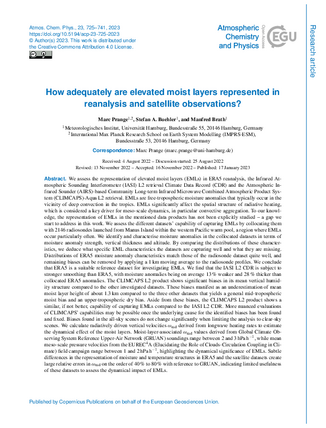Title
How adequately are elevated moist layers represented in reanalysis and satellite observations?
Authors
Prange, M., Buehler, S. A., and Brath, M.
Published
by Atmospheric Chemistry and Physics (ACP) at 2023-01-17
Abstract
We assess the representation of elevated moist layers (EMLs) in ERA5 reanalysis, the Infrared Atmospheric Sounding Interferometer (IASI) L2 retrieval Climate Data Record (CDR) and the Atmospheric Infrared Sounder (AIRS)-based Community Long-term Infrared Microwave Combined Atmospheric Product System (CLIMCAPS)-Aqua L2 retrieval. EMLs are free-tropospheric moisture anomalies that typically occur in the vicinity of deep convection in the tropics. EMLs significantly affect the spatial structure of radiative heating, which is considered a key driver for meso-scale dynamics, in particular convective aggregation. To our knowledge, the representation of EMLs in the mentioned data products has not been explicitly studied – a gap we start to address in this work. We assess the different datasets' capability of capturing EMLs by collocating them with 2146 radiosondes launched from Manus Island within the western Pacific warm pool, a region where EMLs occur particularly often. We identify and characterise moisture anomalies in the collocated datasets in terms of moisture anomaly strength, vertical thickness and altitude. By comparing the distributions of these characteristics, we deduce what specific EML characteristics the datasets are capturing well and what they are missing. Distributions of ERA5 moisture anomaly characteristics match those of the radiosonde dataset quite well, and remaining biases can be removed by applying a 1 km moving average to the radiosonde profiles. We conclude that ERA5 is a suitable reference dataset for investigating EMLs. We find that the IASI L2 CDR is subject to stronger smoothing than ERA5, with moisture anomalies being on average 13 % weaker and 28 % thicker than collocated ERA5 anomalies. The CLIMCAPS L2 product shows significant biases in its mean vertical humidity structure compared to the other investigated datasets. These biases manifest as an underestimation of mean moist layer height of about 1.3 km compared to the three other datasets that yields a general mid-tropospheric moist bias and an upper-tropospheric dry bias. Aside from these biases, the CLIMCAPS L2 product shows a similar, if not better, capability of capturing EMLs compared to the IASI L2 CDR. More nuanced evaluations of CLIMCAPS' capabilities may be possible once the underlying cause for the identified biases has been found and fixed. Biases found in the all-sky scenes do not change significantly when limiting the analysis to clear-sky scenes. We calculate radiatively driven vertical velocities ωrad derived from longwave heating rates to estimate the dynamical effect of the moist layers. Moist-layer-associated ωrad values derived from Global Climate Observing System Reference Upper-Air Network (GRUAN) soundings range between 2 and 3 hPa h−1, while mean meso-scale pressure velocities from the EUREC4A (Elucidating the Role of Clouds-Circulation Coupling in Climate) field campaign range between 1 and 2 hPa h−1, highlighting the dynamical significance of EMLs. Subtle differences in the representation of moisture and temperature structures in ERA5 and the satellite datasets create large relative errors in ωrad on the order of 40 % to 80 % with reference to GRUAN, indicating limited usefulness of these datasets to assess the dynamical impact of EMLs.
Citation
Prange, M., Buehler, S. A., and Brath, M.: How adequately are elevated moist layers represented in reanalysis and satellite observations?, Atmos. Chem. Phys., 23, 725–741, https://doi.org/10.5194/acp-23-725-2023, 2023.
Download
Full article (PDF)

